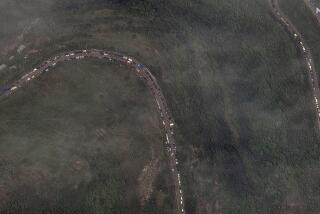A Country Made and Unmade by Water
- Share via
TASHKENT, UZBEKISTAN — The gods played havoc with rain last summer. The Mekong River in Vietnam and the Ganges River in eastern India overflowed their embankments after late monsoon storms, displacing millions of people. But in Central Asia, where no rain has fallen and the renowned Amu Darya River runs dry, the absence of water is more than a cruel trick of nature. It is also a sharp reminder that public policy, not fate, will make the difference between progress and decline in the region’s struggling states.
The parched fields of southern Tajikistan tell grim tales. Stumps of stalks dot a landscape that should yield cotton and wheat; harvest-season markets are almost empty. No summer rain, no autumn crops--and no seeds for planting, no drinking water, hydroelectric power or export earnings. Tiny Tajikistan, tucked in an almost inaccessible corner of the high Pamir Mountain range, is tied tightly to a trading market that survives by squeezing the most out of bits of arable land. Its small economy joins modern cash and old-fashioned barter and is easily buffeted by even temporary reverses. This summer’s crisis shares the follies of nature with the folly of men.
Tajikistan is a place defined by water: Its rivers nurtured antique cultures and Soviet dams; its poets still recite Persian couplets to the sound of waterfalls and urban fountains. Water made it what it was, and now, what it is not. The Soviet Union’s overseers created economies of scale through divisions of labor, and for Tajiks, that meant an economy based on water and an irrigation system organized around cotton exports. Tajikistan supplemented Uzbekistan’s enormous cotton crop and received natural gas and significant subsidies in return.
Independent Tajikistan continues this practice. Cotton production and export are strictly controlled by the government, which sells cotton futures by setting quotas for its farmers. It can do this because, the lures of capitalism notwithstanding, most land is owned by the state. In today’s shaky, semi-market economy, the state gives civil servants, including doctors and teachers, small plots of land to substitute for missing salaries; health, education and everything else depends on the produce from tired lands. But this social safety net is based on a scarce resource, and this year, it is an unreliable one. President Imamali Rahmanov has made state land ownership a constitutional precept and an economic myth, but even he can’t control the rain.
Shedding the skin of the old Soviet Union is not easy, and acquiring a new shell is harder still. The grand stories that drove Soviet policies--collectivism, egalitarianism and accelerated millenarianism--don’t work in today’s Central Asia. Tajiks have deliberately forsaken 20th-century fables for the romance of the ancient Samanid dynasty, associating their contemporary state with a 1200-year-old empire of startling cultural proportions. But Samanid archeology now lies elsewhere: in bustling Mashad in eastern Iran; in Herat, an emblem of Afghanistan’s destruction; and in Samarkand, Bukhara and Khiva, which sit, almost tauntingly, on the Uzbek side of a rarely trespassed border.
National boundaries hold heavy burdens for the little states of Central Asia, which seek economies to suit their needs and political systems to propel their ambitions. Tajikistan’s nine years of independence have witnessed civil war, unanticipated deprivation and increasingly high barriers to the territories of neighboring republics. Tajiks have watched narcotics and gunrunners and frustrated opposition fighters fan out across the entire region, using mountain passes as transit routes for a new century’s nascent politics. Among these contradictory forces, the government of Tajikistan has tried to write a script for a country that cannot survive without its neighbors but is hard-pressed to live with them.
Every myth carries a message. When the government of Tajikistan argues that its country is simply a path for other people’s problems, it is pleading to be absolved of responsibility for future regional instability. When it proclaims that its own civil war was the result of disparities among its regions, it is asking for external assistance to close the gap and overlooking the political causes of continuing restiveness. When it insists that arable land is the sole province of the state, it is refusing to share power with its people or relinquish control to them.
Like so much else in this place between Europe and Asia, Tajikistan’s drought is really a problem of power. Arable land is the fulcrum of the country’s economy: monopoly of land ownership means monopoly of power. Rahmanov allowed parliamentary elections, not quite free and fair, but then held a presidential election in which he was the only candidate. He is banking on stern control to see his country to a brighter future. His defenders count him as a peacemaker; detractors suggest that little about the country or its leaders can be taken for granted.
Unpredictability is a byword for Central Asia’s politics this year. Just across Tajikistan’s heavily guarded southern border--a more effective deterrent for refugees than drug traders--the Taliban is fighting to eliminate Ahmed Shah Masoud, an ethnic Tajik with close ties to Dushanbe. Disenchanted Uzbeks gather under an Islamist umbrella that has sparked ire and repression in Tashkent and, now, in Tajikistan as well. By using Tajikistan as an occasional haven, they have connected the Tajik opposition to a drama that spills across borders into Kyrgyzstan and beyond. Tajikistan has become an unwilling but highly involved actor in a regional drama that pits veteran apparatchiks against the harbingers of an indeterminate, possibly Islamist-leaning future.
In top-heavy, state-centric political societies, volatility often provokes rough responses. Tajikistan is still riding a psychological high after ending its civil war and establishing a political pecking order out of post-conflict chaos. It doesn’t yet have the careworn feel that typifies authoritarian governance in nearby countries such as Uzbekistan, Kazakhstan and Turkmenistan. But although it can’t ignore its neighbors--too much depends on lowering barriers, not raising them--it can’t thrive if it copies them, either.
Drought-stricken farmers are unlikely to interpret their potential humanitarian crisis as a political opportunity to change Rahmanov’s policies. But Tajikistan’s delayed transition from statist economics to a society anchored in private initiative and public choice requires nothing less. To unshackle the economy from the state, politics must finally be dislodged from its singular authority. As farmers say about late rains, it’s about time. *
More to Read
Sign up for Essential California
The most important California stories and recommendations in your inbox every morning.
You may occasionally receive promotional content from the Los Angeles Times.













